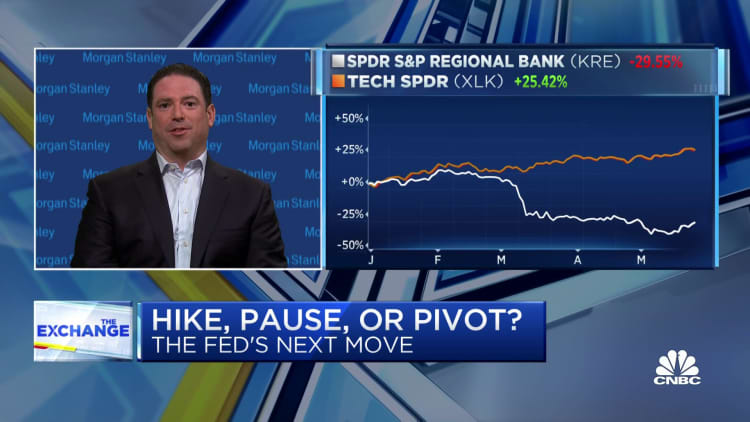[ad_1]
Former Federal Reserve Board Chair Ben Bernanke speaks during a discussion on “Perspectives on Monetary Policy” during the Thomas Laubach Research Conference at the Federal Reserve Board building in Washington, DC, May 19, 2023.
Saul Loeb | AFP | Getty Images
WASHINGTON — Former Federal Reserve Chair Ben Bernanke, who guided the central bank and the U.S. economy through the Great Recession, thinks central bankers still have work to do to bring down inflation.
That work, he and economist Olivier Blanchard argue in an academic paper released Tuesday, will entail slowing down what has been a phenomenally resilient labor market.
The duo does not present specific prescriptions for how much unemployment needs to rise, but they do suggest it’s possible for the current Fed to orchestrate its way out of this predicament without severely tanking the U.S. economy.
“Looking forward, with labor market slack still below sustainable levels and inflation expectations modestly higher, we conclude that the Fed is unlikely to be able to avoid slowing the economy to return inflation to target,” Bernanke and Blanchard wrote in the paper.
Since leaving the Fed in 2014, Bernanke has been a distinguished senior fellow at the Brookings Institution. Blanchard is a senior fellow at the Peterson Institute for International Economics.

Their paper notes that inflation has evolved since ballooning to a 40-year high in the summer of 2022. Initially, prices jumped as consumers used stimulus from Congress and the central bank to shift spending from services to goods, creating logjams in supplies and juicing inflation.
However, they note the new phase is now being pushed by a rise in wages trying to catch up to the surge in prices. The good news is that such shocks are generally controllable, but they said the Fed needs to keep trying to address the labor situation in which the unemployment rate is at 3.4% and there are still about 1.6 open jobs for every available worker.
“The portion of inflation which traces its origin to overheating of labor markets can only be reversed by policy actions that bring labor demand and supply into better balance,” Bernanke and Blanchard say.
A look forward and back
The paper, though, is as much about what caused a surge that took headline inflation as gauged by the consumer price index above 9% last year as it is what happens from here.
Most economists agree that a combination of trillions in government spending combined with zero interest rates and nearly $5 trillion in bond purchases from the Fed flooded the economy with money and created distortions that led to soaring prices.
In a forum Tuesday presented by the Brookings Institution, Bernanke, Blanchard and other high-profile economists and academics discussed the root causes and what policymakers should do as they review policies for the future.
Among the considerations were the factors of supply and demand, how much Covid itself influenced consumer decisions, and whether a new policy framework the Fed adopted in September 2020 that sought not only employment that was full but also “broad-based and inclusive” played a role in the economic dynamics.
“The quantitatively larger sin was fiscal policy, especially for the year 2021. The less forgivable sin, though, was monetary policy,” said Jason Furman, former chair of the Council of Economic Advisers and now an economics professor at Harvard.
“I have lower expectations for fiscal policy. When they get the sign right, I’m pleasantly surprised,” he added. “Monetary policy made the error again and again and meeting after meeting. … I do have higher expectations for the Fed than just getting the sign right.”
As inflation rose past the Fed’s 2% target, policymakers persisted in calling the trend “transitory” and did little other than to begin discussing when it would reduce its bond purchases. The Fed only began raising interest rates in March 2022, a full year after its preferred inflation gauge eclipsed the target.
Since then, policymakers have raised benchmark interest rate 10 times for a total of 5 percentage points, taking the fed funds rate to its highest level in nearly 16 years.
‘An error of tactics’
He also noted the Fed was hardly alone: Many other global central banks chose not to raise rates amid the inflation spike.
“No advanced economy central bank began to hike rates until inflation exceeded target,” Clarida said. “Why this happened, obviously, is a very important and interesting question that says more about the practice of inflation-targeting central banking in the sphere than it does about any particular implementation of a framework.”
The Bernanke-Blanchard paper notes the danger inherent in central banks letting inflation go on for too long and the impact that has on expectations for prices.
“The longer the overheating episode, the stronger the catch-up effect, and the weaker the anchoring of expectations, the larger is the effect of labor market tightness on inflation, and, implicitly, the stronger the eventual monetary contraction needed to return inflation to target, all else equal,” they wrote.
[ad_2]

